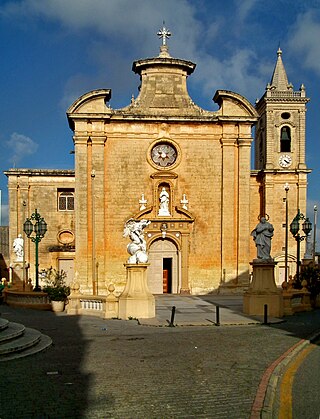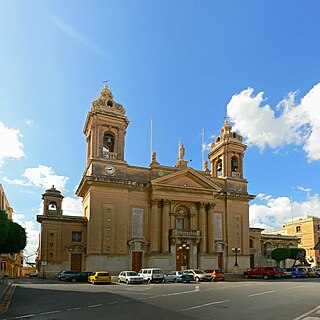
Fgura is a town in the South Eastern Region of Malta. It has a population of 13,066 as of 2021. Its northern fringes are bordered by the Cottonera Lines of fortifications while it merges with the towns of Żabbar to the east and Paola and Tarxien to the West. A modern settlement, Fgura expanded to the outskirts of the Grand Harbour area and was one of the fastest-growing towns of Malta. Fgura has grown to become one of the foremost commercial areas in the central-southern part of the island. Today, Fgura has one of the highest population densities in the country.

Birkirkara is a city in the central region of Malta. It is the second most populous on the island, with 24,356 inhabitants as of 2020. The town consists of five autonomous parishes: Saint Helen, Saint Joseph the Worker, Our Lady of Mount Carmel, Saint Mary and San Gorg Preca. The city's motto is In hoc signo vinces, and its coat of arms is a plain red cross, surmounted by a crown.

Balzan is a municipality in the Central Region of Malta, one of the so-called three villages, together with Attard and Lija. The village originally consisted of a group of small dwellings and farms but eventually grew, becoming a parish in the 17th century. As of 2021, the town registered a population of 4,774 inhabitants.

Victoria, also known among the native Maltese as Rabat or by its title Città Victoria, is an administrative unit of Malta, and the main town on Gozo,. Victoria has a total population of 6,901, and by population, is the largest locality in Gozo.

Rabat is a town in the Northern Region of Malta, with a population of 11,497 as of March 2014. It adjoins the ancient capital city of Mdina, and a north-western area formed part of the Roman city of Melite until its medieval retrenchment. The Apostolic Nunciature of the Holy See to the Republic of Malta is seated in this village. The Local Council of Rabat is also the administrator of Baħrija. Parts of the films Munich and Black Eagle were shot in Rabat. In December 1999, Mtarfa was split from Rabat to form a separate Local Council by Act XXI, an amendment to the Local Council Act of 1993.

Mosta is a small but densely populated city in the Northern Region of Malta. The most prominent building in Mosta is the Rotunda, a large basilica built by its parishioners' volunteer labour. It features the world's 3rd largest unsupported dome, and displays a replica of a German bombshell that famously crashed through the dome but did not detonate upon impact.

Tarxien is a town in the South Eastern Region of Malta. Its population stood at 8583 in March 2014.

Żurrieq is a town in the Southern Region of Malta. It is one of the oldest towns in the country, and it has a population of 11,823 inhabitants as of March 2014. Żurrieq is one of the 10 parishes to be documented in 1436 and it is dedicated to Saint Catherine. The island of Filfla is administratively a part of the town. The town stretches from Nigret to Ħal Far. In old times the town was had a border with Żejtun. The village of Qrendi used to be part of the parish of Żurrieq until 1618 when it was made into its own parish.

Qormi, also known by its title Città Pinto, is a city in the Southern Region of Malta, southwest of Valletta in the centre of the island. It has a population of 16,324, making it Malta's fifth-largest city.

Dingli is a village in the Northern Region of Malta, with a population of 3,865 as of 2021. It is 13 kilometres from the capital Valletta and two kilometers from the nearest town, Rabat. The village lies on a plateau some 250 metres above sea level, which is one of the highest points of Malta. The area provides not only open sea views over the tiny, uninhabited isle of Filfla, but is also a good vantage point over Malta. From the cliffs there are also views of the nearby Buskett Gardens and Verdala Palace. The Cliffs were also the site of the mysterious death of Mike Mansholt.

Paola is a town in the South Eastern Region of Malta, with 8,706 inhabitants as of 2019. The town is a commercial centre in the Southern Harbour area of Malta, about 5 km from the capital Valletta, contiguous to Tarxien and Fgura, with which it forms a single urban area. Paola is named after Grand Master Antoine de Paule, who laid the foundation stone in 1626.

Gudja is a village in the Southern Region of Malta, with a population of 3,148 as of March 2017. The village is located on high grounds, south of Valletta. It is administered by the Gudja Local Council. A number of schools, clubs, public gardens and recreations places are found around the village.

Żebbuġ[ħazˈzɛbbʊtʃ], also known by its title Città Rohan, is a city in the Southern Region of Malta. It is one of the oldest towns in the country, and its population is 11,074 as of June 2021.

Malta is for non-local government purposes divided into districts as opposed to the local government localities. The three main types of such districts – statistical, electoral at national level, and policing – have no mainstream administrative effect as the local councils form the first-tier – moreover only administrative tier – divisions of the country.

St. George's Basilica or the Basilica and Collegiate Parish Church of Saint George, also simply known as San Ġorġ in Maltese, is a historic Baroque church situated in the middle of Gozo, the second largest island in the Maltese archipelago, and is surrounded by a maze of old narrow streets and alleys. Today's basilica was built between 1672 and 1678.

St Helen's Basilica is an 18th-century Roman Catholic church situated in Birkirkara, Malta. It is built on the baroque design by Salvu Borg and built by Mason Domenico Cachia. The design was inspired, and is similar, to the Mdina Cathedral by Lorenzo Gafa. It was built to replace the role of the main old Parish Church of St. Mary that was damaged in the 1856 earthquake. It eventually became the Collegiate Church and then a Minor Basilica. The current parish archpriest is Mons Louis Suban.

The Basilica of the Nativity of Mary or Basilica of Our Lady of Victories is a Roman Catholic parish church located at Senglea, Malta. It is dedicated to the Nativity of the Virgin Mary.

The Basilica of St Dominic or also known as the Basilica of Our Lady of Safe Haven and St Dominic is one of the three parish churches of Valletta, Malta. It is administered by the Dominican Order whose convent is located behind the church.

The St. Ubaldesca Church is a 17th-century baroque church built during the Order of St. John in Paola, Malta. The building is a historic landmark, being the oldest church established in the locality and is listed on the National Inventory of the Cultural Property of the Maltese Islands (NICPMI).

The Parish Church of Saint Mary, commonly known as il-Knisja l-Qadima is a Roman Catholic parish church in Birkirkara, Malta, dedicated to the Assumption of Mary. It was built in the 17th century, and it has a Renaissance design attributed to the architects Vittorio Cassar and Tommaso Dingli.
























